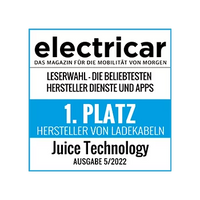Electric vehicles are subject to many prejudices, which are only reinforced by half-knowledge. They are not efficient, do not have enough range and, after their lifetime, would pose an acute threat to the environment because of the battery.
The fact is that these assessments – and the resulting concerns about the environment – are preventing many people from buying a purely electric car, despite a clear upward trend in sales figures.
We are happy to help and explain how electric car batteries are recycled and how they are destined to have a long life long before they are recycled. Because unlike combustion engines, the "used" batteries of electric cars can even support the transformation to renewable energies.
The chapters at a glance
- How long does my electric car battery last?
- Can the battery of an electric car still lose too much power prematurely?
- Second Life: How can an electric car battery be reused?
- Conclusion
How long does my electric car battery last?
This phenomenon is familiar from laptop or cell phone batteries: the performance continuously decreases after frequent charging and the usage time decreases.
Reasons for this include heating up when charging and discharging the battery, deep discharge when not in use or calendar aging, which damage the chemistry of the battery cells.
The solution to this problem is intelligent battery management.
The battery of an electric car consists of individual modules, which in turn consist of individual cells. The temperature and voltage of each cell is determined using a cell monitoring circuit and then evaluated by the intelligent battery management controller. This ensures that the cell chemistry does not get too hot or too cold. This means that the vehicle battery can be much better protected against loss of capacity, which in turn extends its service life.
An example:
For a Tesla Model S with a range of 500 km per battery charge, 3,000 full charge cycles are realistic before the battery's performance decreases and it still has around 80 percent of its capacity.
A full charge cycle is defined as the complete discharging and recharging of the battery. If you multiply the 500 km range by 3,000 full charge cycles, you get a total range of 1,500,000 km before the capacity drops.
Likewise, with an electric car it is not necessary to run the battery completely empty before recharging it.
This procedure is familiar from earlier cell phone or laptop batteries. This means that charging while shopping, at work or at your favorite restaurant is no problem at all - you can use any charging option without worry.
If you want to protect your battery, you should keep the charge level between 20 and 80 percent as often as possible and charge at fast charging stations as rarely as possible.
Can the battery of an electric car still lose too much power prematurely?
Whether in electric cars, cell phones or laptops - lithium-ion batteries are installed in all devices. In principle, these are considered to be very reliable energy storage devices. However, in rare cases, they can lose too much power prematurely.
Factors such as extreme temperatures, a sporty driving style or faulty battery chemistry can affect the service life. Depending on the purchase contract, this can give rise to a warranty claim. Most manufacturers offer a warranty of eight years and a maximum mileage of 160,000 kilometers.
A battery that falls below a certain capacity (usually 70 - 80 percent) within this period or mileage is covered by the manufacturer's warranty and will be repaired or replaced free of charge. Lexus is breaking all records and even setting the warranty for the new UX300e at ten years and one million kilometers. However, a complete battery replacement is rarely necessary, as many problems can be solved by replacing individual battery modules.
Second Life: How can an electric car battery be reused?
A battery is considered "used up" for mobile traffic as soon as its total capacity is only 70 to 80 percent. However, from an ecological and economic point of view, it makes sense to continue to use it as an energy storage device before recycling it.
A prominent example: The car manufacturer BMW started operating its storage farm in Leipzig in 2017 with 500 used batteries from electric vehicles as second-life energy storage. This will absorb high load peaks that can occur during production and compensate for periods of low wind.
A used battery can also be used in private households, for example to store the electricity from a photovoltaic system cost-efficiently instead of feeding it cheaply into the grid. A battery with a capacity of 20 kWh can already be used as a buffer for a family household.
Because the battery cells are subjected to a more even load, as constantly changing charging and discharging cycles are eliminated, the battery can be used for up to 20 years in its second life before final recycling even needs to be considered.
Conclusion
The batteries of electric cars already have a very long service life, which will increase even further in the future .
If a battery loses too much of its original capacity at the end of its life, it is not immediately dismantled but is used as an energy buffer for years or even decades. This means that energy from renewable sources such as wind and sun can be used for the energy transition, so that environmentally harmful energy sources do not have to be used even at night or when there is no wind.
If recycling is the only option after many years of use, at least 90 percent of the old battery can be reused as raw material for the next electric car battery.













